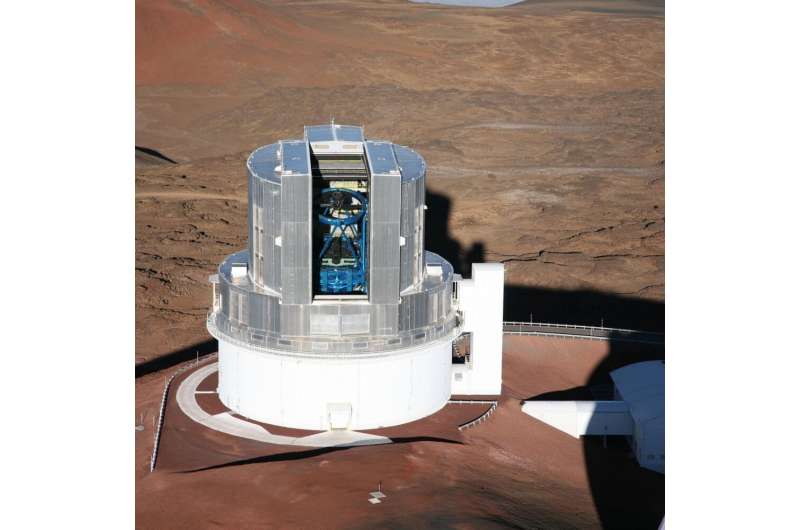The 20440 pixel MKID device designed for MKID Exoplanet Camera is the highest pixel-count superconducting detector array at any wavelength. Credit: Image courtesy of researchers
In the years since astronomers discovered the first exoplanet—a planet that orbits a star outside the solar system—more than 4,000 have been observed. Usually, their presence is given away by the slight effects they have on their parent stars, which vastly outshine them. For a decade and half, scientists have been trying to image exoplanets directly, but the Earth's atmosphere presents a major impediment when they attempt to leverage large ground-based telescopes.
Now, a team of U.S. and Japanese scientists and engineers that includes researchers at UC Santa Barbara have developed a new exoplanet-hunting camera. Deployed at the Subaru Telescope on Maunakea, Hawai'I, the device is the world's largest superconducting camera by pixel count and will pave the way for direct imaging of extra-solar planets in the near future. An instrument paper appearing in Publications of the Astronomy Society of the Pacific announced the new device to the astronomical community.
Constructed by researchers in the lab of Professor Ben Mazin, the MKID Exoplanet Camera (MEC) uses Microwave Kinetic Inductance Detectors (MKIDs) to enable scientists to directly image exoplanets and disks around bright stars. The detector runs at a brisk 90 millikelvin—just a touch over absolute zero—and is the first permanently deployed superconducting camera that operates in the optical and near infrared spectrum.
"In exoplanet direct imaging, you are attempting to image planets that are millions of times fainter than their parent stars," said Sarah Steiger, a doctoral student in the Mazin lab who worked on the MKID pipeline. "It's the equivalent of trying to see a firefly next to a fully lit football stadium from a plane.
"What's more, if you are doing this from the ground, you must look through Earth's turbulent atmosphere," she continued. This turbulence is what causes stars to twinkle in the night sky, and is a perennial headache to astronomers, distorting images and casting starlight on dim exoplanets.
"It's a constant battle to prevent stray light from the star from completely overwhelming the planet," said doctoral student Neelay Fruitwala.
Modern observatories use adaptive optics to correct these distortions. The systems rely on rapid feedback loops and complex algorithms to bend a telescope's mirror thousands of times per second in ways that counteract the effects of the atmosphere, enabling scientists to recover an image as though the telescope were in space.
"These very complicated adaptive optics systems let us discover planets like those in HR 8799, which is a system with four planets all above Jupiter's mass orbiting in it," said Mazin. But they can also scatter light, which obscures faint exoplanets. "We found that just using adaptive optics by itself was only going to find us a handful of planets—namely those still glowing with the heat of their formation—which are just not that common in our stellar neighborhood."
The Subaru Telescope on the summit of Maunakea, Hawaii. Credit: National Astronomical Observatory of Japan (NAOJ)
Another advantage of MKIDs lies in their ability to determine the energy of each photon that hits the detector. "This allows us not only to determine a planet's brightness," Steiger said, "but also to get a spectrum (the brightness as a function of energy), which can reveal additional information about an exoplanet's properties, such as its age, mass and potentially atmospheric composition."
More advanced detectors employ a coronagraph, which blocks out some of the light from the host star so scientists can better discern the light reflecting off the planet itself. This is important for imaging nearby systems, most of which aren't particularly young. However, getting the best performance from such a setup requires extremely good adaptive optics.
"These instruments are sort of hitting a wall right now," Mazin said. "They can block out the light from the star by about a factor of a million, but the problem is that most planets are more like a billion times fainter than their parent star."
One advantage of MKIDs over traditional cameras is that they are very fast. These detectors can read out data thousands of times per second, which are the speeds required to keep up with an adaptive optics system, Steiger explained. This allows an MKID to further clean up an image by communicating with the observatory's adaptive optics system to remove some of the scattered and diffracted starlight. This pushes the limits of how faint an exoplanet can be imaged.
The MKID Exoplanet Camera should expand the range of exoplanets that astronomers can directly image to those near Earth. These are the most important because we can characterize them in greater detail, said coauthor Olivier Guyon, the project scientist in charge of the Subaru Coronagraphic Extreme Adaptive Optics (SCExAO) instrument.
The ultimate goal is to search for evidence of life, and the MEC is an important step in this journey. "We're not going to be able to do that with Subaru, or with any of the current telescopes, because they're just a bit too small," Guyon said. "But we're preparing for the next big step, which is to deploy exoplanet imaging cameras on larger telescopes such as the Thirty Meter Telescope. When those telescopes come online, the same technologies, the same camera, the same tricks will allow us to actually look for life."
That said, there's still a lot of work left to do, mostly on the MEC's software and algorithms. The team received a large grant from the Heising-Simons Foundation to tackle this problem and further develop fast optical correction over the next few years. "We're throwing every trick in the book at this," Mazin said, "and we're developing new tricks as well."
The authors acknowledge the significant cultural role and reverence that the summit of Maunakea holds within the Hawaiian community and said they feel fortunate to have the opportunity to conduct observations from this mountain.
Provided by University of California - Santa Barbara

























